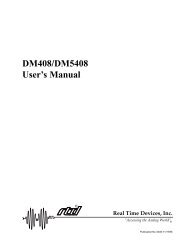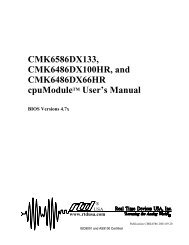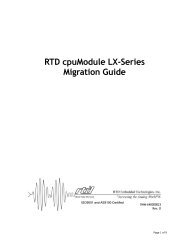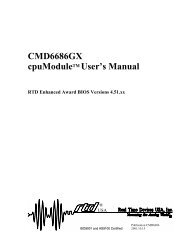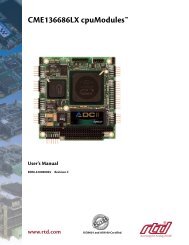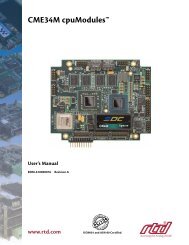Hardware Manual - RTD Embedded Technologies, Inc.
Hardware Manual - RTD Embedded Technologies, Inc.
Hardware Manual - RTD Embedded Technologies, Inc.
Create successful ePaper yourself
Turn your PDF publications into a flip-book with our unique Google optimized e-Paper software.
Board Functionality<br />
Block Diagram<br />
Below is a block diagram of the CM17047. Primary board components are in bold, while external<br />
I/O connections are italicized.<br />
CM17047 Block Diagram<br />
USB<br />
Port 1<br />
USB<br />
Port 2<br />
USB<br />
Port 3<br />
USB<br />
Port 4<br />
USB<br />
Port 5<br />
NEC µPD720101<br />
USB Controller<br />
USB Routing Logic<br />
EHCI Core<br />
(Ports 1 through 5)<br />
OHCI Core #1<br />
(Ports 1, 3, and 5)<br />
OHCI Core #2<br />
(Ports 2 and 4)<br />
PCI Arbiter<br />
PCI Bus<br />
USB Controller Cores<br />
The CM17407 uses the NEC µPD720101 USB 2.0 Host Controller. It is a standard PCI USB 2.0<br />
controller, and is compatible with all USB 2.0-compliant devices. As per the USB 2.0<br />
specification, it is fully backwards compatible with USB 1.1 and 1.0 devices.<br />
The NEC µPD720101 includes three USB controller cores. The primary core is an Enhanced<br />
Host Controller Interface (EHCI), which provides high-speed USB 2.0 connections to all 5 ports.<br />
The other two cores are Open Host Controller Interface (OHCI) cores, which provide full-speed<br />
and low-speed connections to the ports. Which core is used will be determined dynamically by<br />
the USB routing logic.<br />
When a USB device is attached, the NEC µPD720101 detects the speed of the device. If it is a<br />
high-speed USB 2.0 device, the EHCI core will be used for that port. If a full-speed or low-speed<br />
device is connected, one of the OHCI cores will be used for that port. This approach allows<br />
slower USB devices to be attached without affecting the performance of faster ones.<br />
Page 9 of 18



